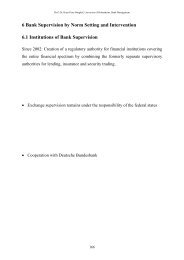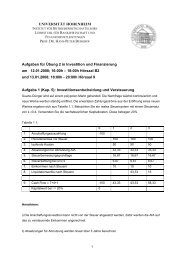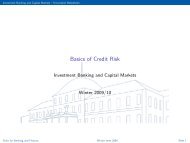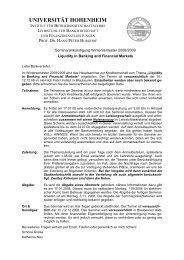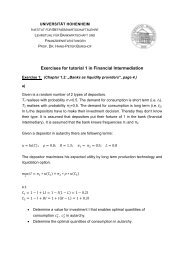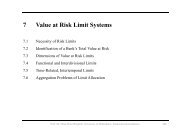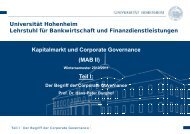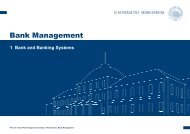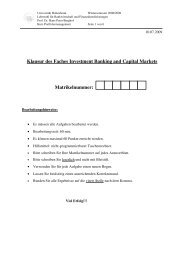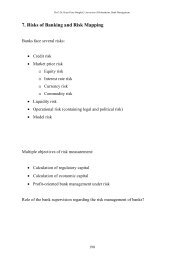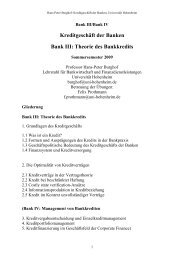Tutorial 2 Course “Financial Intermediation” - Lehrstuhl für ...
Tutorial 2 Course “Financial Intermediation” - Lehrstuhl für ...
Tutorial 2 Course “Financial Intermediation” - Lehrstuhl für ...
Create successful ePaper yourself
Turn your PDF publications into a flip-book with our unique Google optimized e-Paper software.
UNIVERSITÄT HOHENHEIM<br />
INSTITUT FÜR BETRIEBSWIRTSCHAFTSLEHRE<br />
LEHRSTUHL FÜR BANKWIRTSCHAFT UND<br />
FINANZDIENSTLEISTUNGEN<br />
PROF. DR. HANS-PETER BURGHOF<br />
<strong>Tutorial</strong> 2<br />
<strong>Course</strong> <strong>“Financial</strong> <strong>Intermediation”</strong><br />
Exercise 1: (Chapter 1.4, p. 38: “Banks as Delegated Contractors”)<br />
An entrepreneur has the following investment opportunity that generates two possible<br />
returns in the future.<br />
Investment I = 20<br />
Return in condition 1 y1 = 40<br />
Return in condition 2 y2 = 15<br />
Return for liquidation by lender<br />
of capital L = 10<br />
Interest rate i = 0%<br />
Probability of condition 1 p = 0.5
To finance the investment, the entrepreneur can choose between capital market<br />
financing (issue a bond without the possibility to renegotiate) and bank financing (take<br />
out a bank loan with renegotiation possibility). In the case of renegotiation, the bank gets<br />
the revenue w = 0.5 (y-L), where y is the particular project revenue. Moreover, the<br />
lender of capital has the opportunity to liquidate the project preliminary, if the credit<br />
payment is in default. The lender of capital accepts the credit agreement only if the loan<br />
amount is covered by the expected repayment. The entrepreneur can simulate<br />
bankruptcy.<br />
a) Consider the case of bond financing:<br />
Compute the contractually guaranteed repayment amount DA for which the lender<br />
of capital consents to finance the investment.<br />
Compute the agency costs ACA in this contract. For this purpose, compare the<br />
project’s net present values for equity financing and for bond financing.<br />
b) Consider the case of bank financing:<br />
Compute the contractually guaranteed repayment amount DB, for which the<br />
lender of capital consents to finance the investment.<br />
Compute the agency costs ACA in this contract. For this purpose, compare the<br />
project’s net present values for equity financing and for bank financing.
Exercise 2: (Chapter 3.3, p. 36: “Risk Enhancement and Banking Operations”)<br />
There is a bank with the following characteristics:<br />
K = 1.2 R = 2 r = 0.1<br />
K is a risk-free position with secure repayment K in every period.<br />
R is a risky position with the repayment<br />
o R with probability p<br />
o 0 with probability (1-p)<br />
r is the market rate of interest.<br />
a) If the bank maximizes the value of its total capital, from which value of p does the<br />
bank prefer the risky project?<br />
b) Depositors obtain the amount of D in every period. From which value of p does the<br />
bank select the risky project if the bank maximizes the value of its equity (E)? The<br />
bank has no bail-out guarantee in case of bankruptcy.<br />
i) For D = 1.15<br />
ii) For D = 0.9<br />
c) Now, from which value of p does the bank select the risky project if the bank<br />
maximizes the value of its equity (E) and if the bank has a bail-out guarantee?<br />
d) Given a project R with a probability of success p = 0.5. Compute the capital<br />
structure (that is, D) for which the bank just selects the project R, assuming case B<br />
(bail-out guarantee).<br />
e) Assume there is no bail-out guarantee. Compute the capital structure (D) for which<br />
the value of the total capital is maximized (“optimal” capital structure).
f) Please show that a fixed risk premium c does not influence the bank’s incentive<br />
structure, assuming case B (with bail-out guarantee). The risk premium is fixed if it<br />
has to be paid regardless of the investment decision R of K.<br />
g) Please show that a proportional risk premium can influence the bank’s incentive<br />
structure, assuming case B (with bail-out guarantee). The risk premium is<br />
proportional if it rises with the project’s probability of failure in which the bank<br />
invests, i.e. (1-p)*c.<br />
Additional exercise:<br />
h) Please show: stricter equity norms of the type dept capital/total capital ≤ X, that is<br />
D/TC ≤ X, can lead to a greater risk aversion of the bank management. Assume<br />
case L (bankruptcy without bail-out guarantee).<br />
Hint: Express p as a function of D and substitute D by a function in X. Analyze the<br />
effect of a reduction of X.



